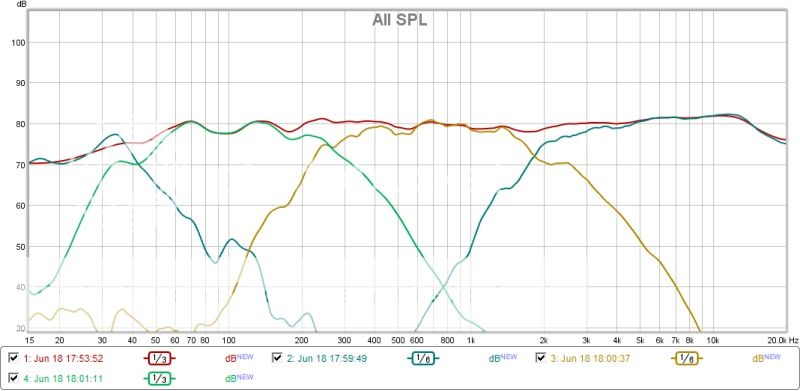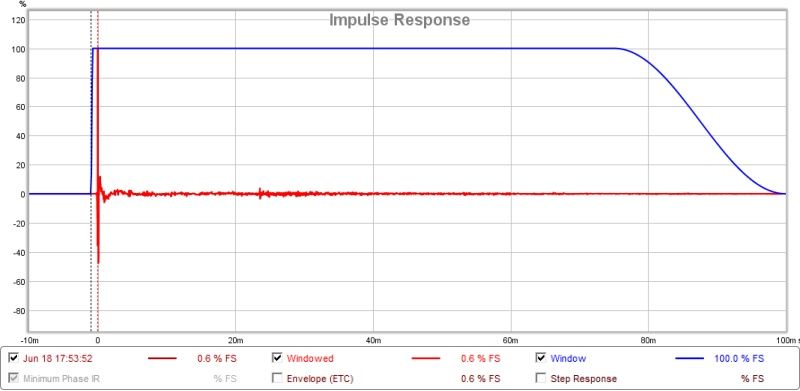Hi guys - sorry I missed your posts - I didn't get an update to state you had added posts!
Well I am currently researching measurement softwear and mic options - looking at probably a USB calibrated mic like the UMIK-1 and REW.
I have been using a very basic LR4 pro audio active crossover - the dbx 234xs. It allows, gain adjustments and crossover point adjustments, but not a lot else. It has been nice playing with crossover points and using my tablet mic with RTA apps to look at driver measurements, but obviously this is extremely 'rough and ready'.
I appreciate I now need to measure the divers in their enclosure to work out phase/driver response in order to start thinking about my DSP crossover implementation.
Hi SPA - I am extremely humbled that you found my DIY project - as you know I took a lot of design cues from the SP1M! I had settled on 450hz and 2kHz as a sensible option to keep to the flattest portions of each driver's passband. So haven't tried the MF/HF crossover at 4.5khz - I will try this tonight!
One thing I have done is try to mitigate diffraction artefacts with wool felt. When I get a chance I will post a few pics, but I have use 12mm black 90% wool felt over the baffle which acts as a support for 5mm acoustic foam. This means it looks like an 'ordinary speaker grille' but solves diffraction problems, rather than adds to them.
Well I am currently researching measurement softwear and mic options - looking at probably a USB calibrated mic like the UMIK-1 and REW.
I have been using a very basic LR4 pro audio active crossover - the dbx 234xs. It allows, gain adjustments and crossover point adjustments, but not a lot else. It has been nice playing with crossover points and using my tablet mic with RTA apps to look at driver measurements, but obviously this is extremely 'rough and ready'.
I appreciate I now need to measure the divers in their enclosure to work out phase/driver response in order to start thinking about my DSP crossover implementation.
Hi SPA - I am extremely humbled that you found my DIY project - as you know I took a lot of design cues from the SP1M! I had settled on 450hz and 2kHz as a sensible option to keep to the flattest portions of each driver's passband. So haven't tried the MF/HF crossover at 4.5khz - I will try this tonight!
One thing I have done is try to mitigate diffraction artefacts with wool felt. When I get a chance I will post a few pics, but I have use 12mm black 90% wool felt over the baffle which acts as a support for 5mm acoustic foam. This means it looks like an 'ordinary speaker grille' but solves diffraction problems, rather than adds to them.
Measurements at last!
So finally got around to taking some measurements with a UMIK-1 and REW.
These are taken in situ at 1m. It is raining here, so no chance to take them outside at the moment.
It gives an idea of on-axis and off-axis performance. I am pleased with the power response, but clearly the freq response is all over the place - I guess partly due to reflections from the front wall and it's poor positioning.
This is with the standard analogue DBX crossover, so I think much better results could be achieved with a miniDSP 4x10 HD (probably the route I am going to go down).
Is the ragged phase response between mid and tweeter due to the poor x-over?
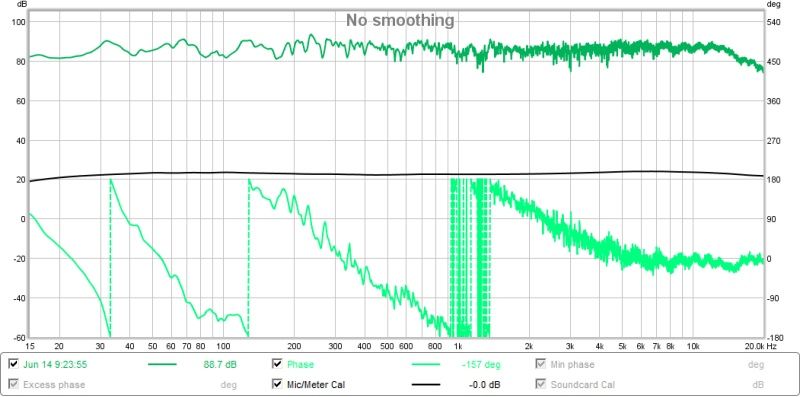

Taken at 0, 15, 30, 45, 60 degrees 1/6th oct smoothing.
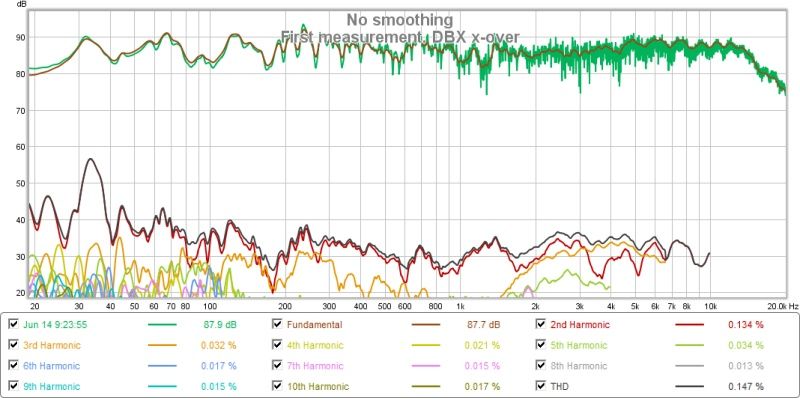
So finally got around to taking some measurements with a UMIK-1 and REW.
These are taken in situ at 1m. It is raining here, so no chance to take them outside at the moment.
It gives an idea of on-axis and off-axis performance. I am pleased with the power response, but clearly the freq response is all over the place - I guess partly due to reflections from the front wall and it's poor positioning.
This is with the standard analogue DBX crossover, so I think much better results could be achieved with a miniDSP 4x10 HD (probably the route I am going to go down).
Is the ragged phase response between mid and tweeter due to the poor x-over?


Taken at 0, 15, 30, 45, 60 degrees 1/6th oct smoothing.

Response look very good! Obviously you have IR gating set t default 500ms? You can use the same measurement and just change IR gating to 5ms, 12ms 60ms. You can also change smoothing to 1/12 or even 1/3. Phase has some artefact, a reflection? Use shorter IR gating.
Directivity is very smooth!
Distortion graph uses some variable gating that can not be adjusted. The level in your distortion mesurement is too low to show nothing else than ambient noise!
Directivity is very smooth!
Distortion graph uses some variable gating that can not be adjusted. The level in your distortion mesurement is too low to show nothing else than ambient noise!
Thanks for your help - I'm a total REW novice!
So I played about with the gating and you were absolutely right, the phase was just artifact from reflections. Here is with 1ms left and 1ms right gating:
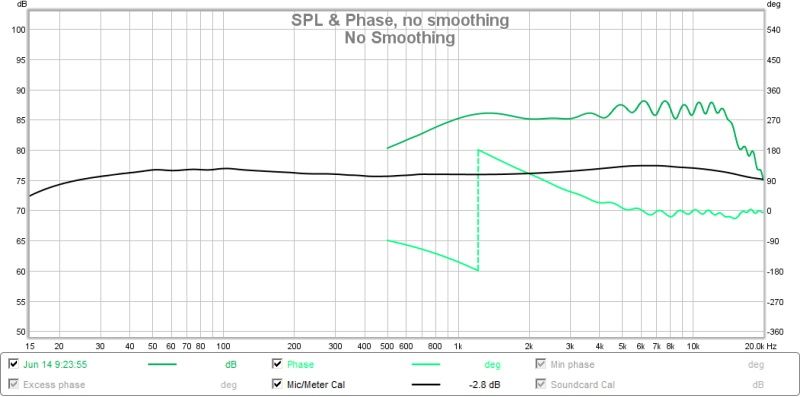
And here with a 60ms window and smoothing:

Do you think I can do substantially better with a miniDSP, or should I await better measurements when I get the outside?
So I played about with the gating and you were absolutely right, the phase was just artifact from reflections. Here is with 1ms left and 1ms right gating:

And here with a 60ms window and smoothing:

Do you think I can do substantially better with a miniDSP, or should I await better measurements when I get the outside?
This on-axis looks excellent to me🙂 A light "recession" from 800Hz to 4kHz will just make the speaker sound very nice and rich( sort of BBC-dip) When we remember the smooth directivity, I think that this is just right - a more even measurement will perhaps sound too bright! If you have padded the mid, you can try less padding and measure/listen. It would be very difficult to do any better with minidsp.
Last edited:
Thanks very much!
I did choose drivers and crossover points where they were very flat throughout - (more than an octave either side), in the hope I would need minimal EQ and slope adjustment.
I can easily adjust for driver sensitivity as I am now using three pro-audio QSC amps, so they have pots on their inputs.
I was fairly certain that I would need a more bespoke active crossover - whether digital or analogue to get a decent power response/freq response, but am very pleasantly surprised by these results (although as I wrote previously, using my CMS65 focal active monitors as a benchmark I felt these speakers were a significant step up even with the standard crossover).
I guess you can use standard LR4 crossover slopes after all if you have very well behaving drivers and pick the off axis behaviour to match at the right points.
My next decision is whether I upgrade my DBX variable slope crossover, to a fixed analogue crossover such as a Marchand . Any suggestions on something that might sound more transparent than the DBX I am currently using? (it is nice not to have to go digital, as I also listen to vinyl).
I did choose drivers and crossover points where they were very flat throughout - (more than an octave either side), in the hope I would need minimal EQ and slope adjustment.
I can easily adjust for driver sensitivity as I am now using three pro-audio QSC amps, so they have pots on their inputs.
I was fairly certain that I would need a more bespoke active crossover - whether digital or analogue to get a decent power response/freq response, but am very pleasantly surprised by these results (although as I wrote previously, using my CMS65 focal active monitors as a benchmark I felt these speakers were a significant step up even with the standard crossover).
I guess you can use standard LR4 crossover slopes after all if you have very well behaving drivers and pick the off axis behaviour to match at the right points.
My next decision is whether I upgrade my DBX variable slope crossover, to a fixed analogue crossover such as a Marchand . Any suggestions on something that might sound more transparent than the DBX I am currently using? (it is nice not to have to go digital, as I also listen to vinyl).
Very well done Bushmeister! Measurements and directivity both look exceptional. Given the very smooth rolloff of the mid and woofer, I'd suggest trying LR2 there. You may have to reverse the phase of the mid and measure for the reverse null at the tweeter xo point....let your ears be the judge but that's the BIG advantage of paper cones is the smooth response and the ability to go LR2 which will provide excellent phase overlapp.
Very well done Bushmeister! Measurements and directivity both look exceptional. Given the very smooth rolloff of the mid and woofer, I'd suggest trying LR2 there...that's the BIG advantage of paper cones is the smooth response and the ability to go LR2 which will provide excellent phase overlapp.
The advantage of LR4 is it gives lower distortion for the system at extremely high levels. With LR2 we are challenging the mid's low end! Remember that real midranges have only 1-2mm Xmax and resonance somewhere between 100-300Hz.
With minidsp advanced plugin it will be relatively easy to make even Duelundish slopes with excellent phase and transient! Bushmeister's W/M acoustic xo is actually a Duelund elliptical in my eyes!
http://www.musicanddesign.com/Speaker_Transient_Analysis.html
Crossovers
We can see from bushmeister's measurements that minimum phase is excellently smooth! (black line at message #64)
I have done thousands of measurements of my 4-way project and consistently LR4 acoustic gives me better off-axis both horizontally and vertically (less variations). In a multi-way speaker it is important to get w and t to match well (in phase) and set the mid between them! This is not so critical with LR4 because the w/t crossing is so low in dB. We start seeing this issue at 30¤ or more horizontal off-axis, but it is important for the sound clarity in a room.
In vertical off-axis, LR4 is much better because the upper driver starts dominating much earlier.
Last edited:
Bushmeister has the ScanSpeak Revelator 12MU mid, which has overkill xmax 11mm
http://www.scan-speak.dk/datasheet/pdf/12mu-8731t00.pdf
So, it would be mechanically safe to try LR2 with W/M.
http://www.scan-speak.dk/datasheet/pdf/12mu-8731t00.pdf
So, it would be mechanically safe to try LR2 with W/M.
Thanks....point taken and I'm surprised to hear about your phasing with LR4....Wow. I wish i had as much luck as you've experienced. I think I'll give LR4 a try with my next project which will be using so not so behaved drivers. Lol
Cheers for your input guys!
Mayhem13 - as Juhazi mentioned LR4 gives much better protection to drivers to keep them only operating within their passband and prevent distortion when playing at high levels.
I am currently driving these with three stereo QSC pro-amps, outputting over 900 watts per speaker, so there is plenty of dynamic headroom, and this was also the main reason for going three-way sealed - so I could get dynamics, rather than running a woofer higher, or a tweeter lower. I like occasionally to play 'room shaking loud' - and these do that well - without it seeming loud at all. As mentioned the mid has loads of linear travel, and the tweeter will play well to a low crossover, whilst I protect the woofer with a 40hz low cutoff, and use subs below this. This allows me to really turn up the volume without concerns and means I can turn off all the limiters/clipping circuits of my amps.
My other reason for going completely sealed was for transient response and GD, which is supposed to be better in sealed designs. I am currently playing with REW to get some measurements of this - I am a novice!
I am so pleased with my new speakers, and having now done blind listening trials against my Focal CMS65s with the help of friends, that I have decided to sell the focals.
I should say that I have covered the baffles in 20mm wool felt in strategic areas to minimise diffraction -with the help of constantly checking measurements with REW, and that my stuffing densities (glass fibre) almost doubled after months of listening and experimenting, so it demonstrates to me, that there are always improvements to be made.
Mayhem13 - as Juhazi mentioned LR4 gives much better protection to drivers to keep them only operating within their passband and prevent distortion when playing at high levels.
I am currently driving these with three stereo QSC pro-amps, outputting over 900 watts per speaker, so there is plenty of dynamic headroom, and this was also the main reason for going three-way sealed - so I could get dynamics, rather than running a woofer higher, or a tweeter lower. I like occasionally to play 'room shaking loud' - and these do that well - without it seeming loud at all. As mentioned the mid has loads of linear travel, and the tweeter will play well to a low crossover, whilst I protect the woofer with a 40hz low cutoff, and use subs below this. This allows me to really turn up the volume without concerns and means I can turn off all the limiters/clipping circuits of my amps.
My other reason for going completely sealed was for transient response and GD, which is supposed to be better in sealed designs. I am currently playing with REW to get some measurements of this - I am a novice!
I am so pleased with my new speakers, and having now done blind listening trials against my Focal CMS65s with the help of friends, that I have decided to sell the focals.
I should say that I have covered the baffles in 20mm wool felt in strategic areas to minimise diffraction -with the help of constantly checking measurements with REW, and that my stuffing densities (glass fibre) almost doubled after months of listening and experimenting, so it demonstrates to me, that there are always improvements to be made.
Last edited:
Make a checkmark for step response and you will see it. FR is much more
relevant for making meaningfull conclusions. Zoom in the first milliseconds
for more detailed display.
relevant for making meaningfull conclusions. Zoom in the first milliseconds
for more detailed display.
Last edited:
Thanks! - after more playing here are the results.... Not the best! But this is a speaker with a straight baffle and no delay or driver acoustic centre corrections. I have also used LR4 electrical crossovers, which provide me with the nice frequency response and phase but of course induce significant timing issues due to being relatively high order. So I guess I shouldn't be surprised they are fairly poor!
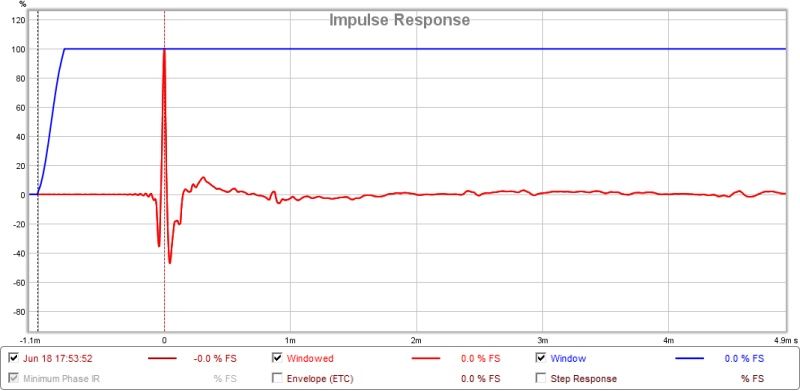

I suppose whilst I may have pretty good frequency response and directivity, a simple analogue crossover will not solve the other issues that DSP can.......


I suppose whilst I may have pretty good frequency response and directivity, a simple analogue crossover will not solve the other issues that DSP can.......
Last edited:
Step and impulse look just right for LR4 xo 3-way. You can use minidsp's dealy settings to set"time alignment", usually gradually more delay for smaller (higher playing) drivers.
Delay and xo-frequency adjustment can (and should) be used for fine-tuning even order LR crossovers. Reverse the phase of the mid driver (from minidsp UI) and look for xrossover nulls - they should be deep and symmetric. Adjust delay and xo-frequency. SEt IR gate short eg. 5ms. W and M xo can be set to different Fq, because we are looking/measuring the actual acoustic output!
My guess is that you should have say 0.20ms delay for mid and 0.30ms delay for T. But as I said previously, you just might have it spot on already!
Delay and xo-frequency adjustment can (and should) be used for fine-tuning even order LR crossovers. Reverse the phase of the mid driver (from minidsp UI) and look for xrossover nulls - they should be deep and symmetric. Adjust delay and xo-frequency. SEt IR gate short eg. 5ms. W and M xo can be set to different Fq, because we are looking/measuring the actual acoustic output!
My guess is that you should have say 0.20ms delay for mid and 0.30ms delay for T. But as I said previously, you just might have it spot on already!
So since building these in the summer I have invested in new amps - mc2, which are fantastic. A new homebrew active crossover. And I have spent a fair amount of time optimising the cabinets.
They have had another 8mm of extensional damping. Further oak bracing. A 2cm layer of wool felt with liquid nails applied internally. And sorbothane gaskets for the mid and tweeters. This last modification made a massive difference to cabinet resonance - see the 'how to brace a speaker' thread for some of my measurements of panel resonances before and after sorbothane gaskets.
My final modification has been a solid oak baffle, 3cm thick which has been attached using melamine tightbond as recommended by Earle Geddes as a good cld layer after a lot of experimentation.
This has created a 5cm thick, very stiff, well damped baffle which is acoustically dead with the stethoscope tap test. It has dropped off nearly all driver resonances to the cabinet, and allowed me to sculpt the oak with my electric plane to minimise diffraction effects. The 5cm depth of baffle also allowed me to seal the tweeters from the main cabinet volume thereby isolating them from the woofers volume.
I also think it looks nicer than the flat black MDF!
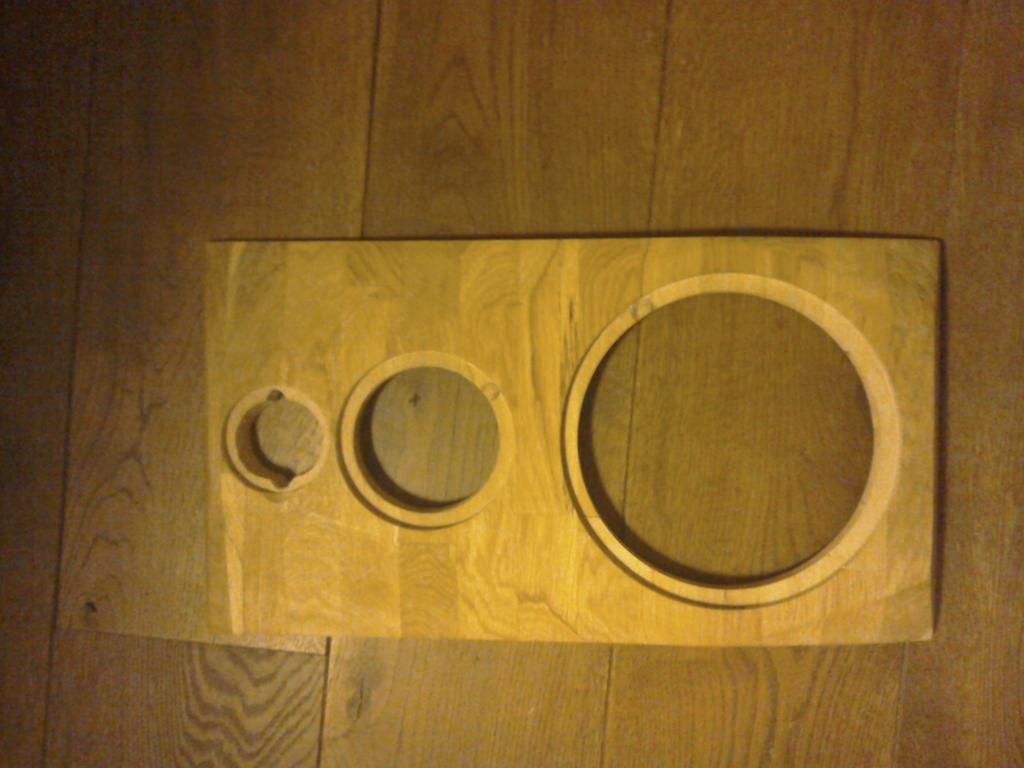
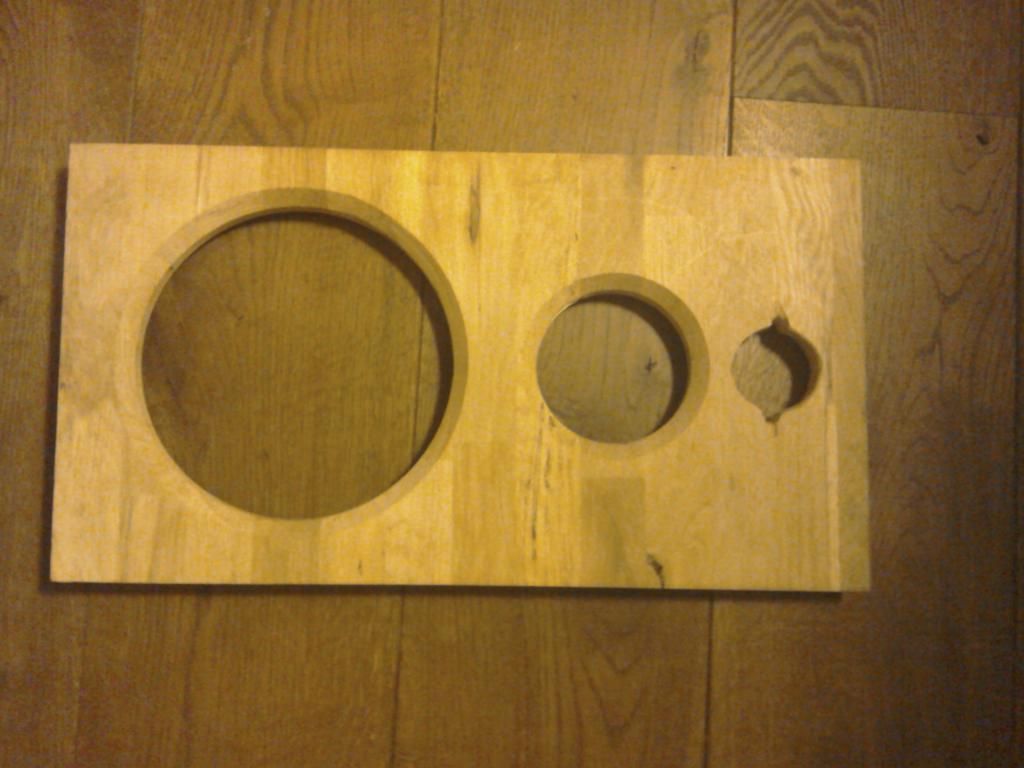

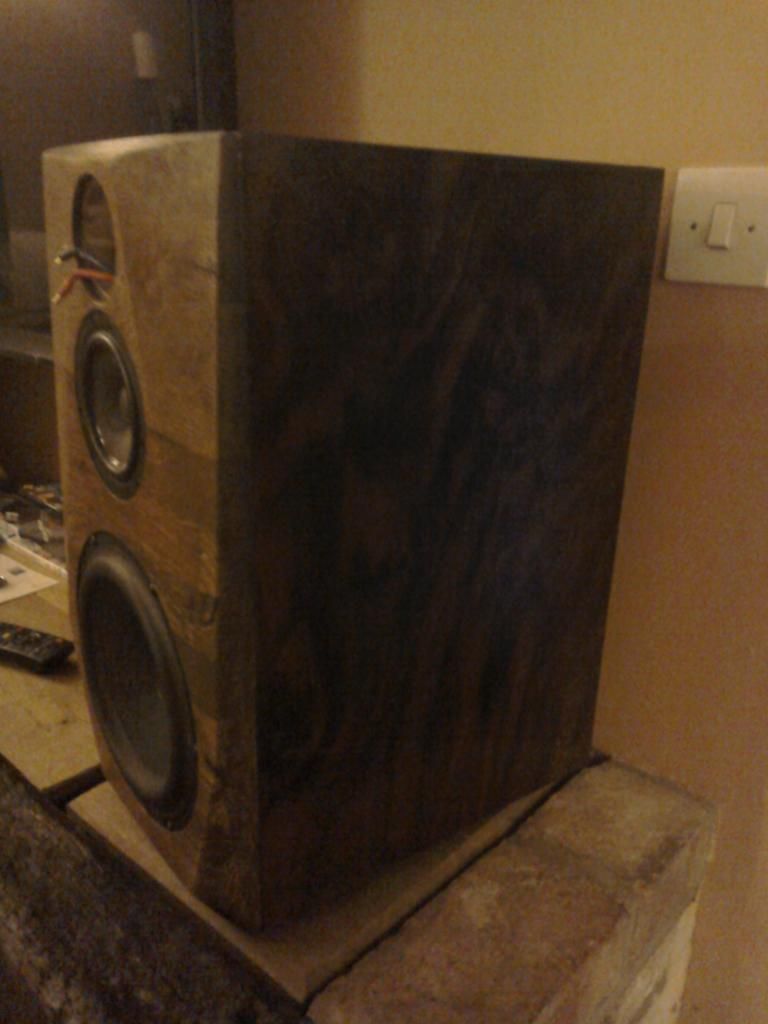
They have had another 8mm of extensional damping. Further oak bracing. A 2cm layer of wool felt with liquid nails applied internally. And sorbothane gaskets for the mid and tweeters. This last modification made a massive difference to cabinet resonance - see the 'how to brace a speaker' thread for some of my measurements of panel resonances before and after sorbothane gaskets.
My final modification has been a solid oak baffle, 3cm thick which has been attached using melamine tightbond as recommended by Earle Geddes as a good cld layer after a lot of experimentation.
This has created a 5cm thick, very stiff, well damped baffle which is acoustically dead with the stethoscope tap test. It has dropped off nearly all driver resonances to the cabinet, and allowed me to sculpt the oak with my electric plane to minimise diffraction effects. The 5cm depth of baffle also allowed me to seal the tweeters from the main cabinet volume thereby isolating them from the woofers volume.
I also think it looks nicer than the flat black MDF!




Last edited:
Looks nice but I do have a thing for classic speaker design.
Glad you like your MC2s!
The are great amps but then I would say that as I use 3 of them myself. ;-)
Glad you like your MC2s!
The are great amps but then I would say that as I use 3 of them myself. ;-)
- Status
- Not open for further replies.
- Home
- Loudspeakers
- Multi-Way
- Sealed three way monitor - anyone spot any probs before I start?
